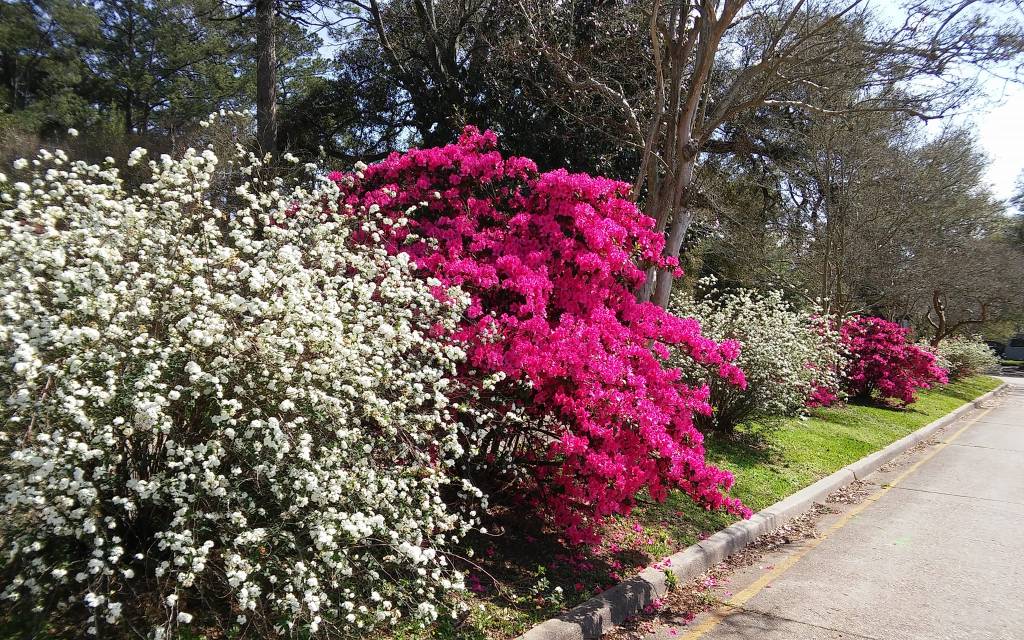Splendor of Spring
Published 12:00 am Tuesday, March 26, 2024

- Azaleas multiple.jpeg
Travel Acadiana I Experience the Azalea Trail
Splendor of Spring
Blooms are now in Season
Among Lafayette’s crowning glories is the Azalea Trail, a picturesque path that comes alive each March with the vibrant hues of blooming azaleas. If you’re seeking a springtime adventure, look no further than this floral wonderland, where nature’s palette bursts into a symphony of color. The trail not only highlights the beauty of azaleas but also reflects the rich cultural heritage of the area.
All About Azaleas
The deciduous shrub, with vibrant and diverse blooms, has a rich history that intertwines with both Eastern and Western cultures.
Azalea History
Originally from East Asia azaleas were introduced to the Gulf Coast two centuries ago. The name “azalea” is of Greek origin, meaning “dry,” highlighting the plant’s preference for dry soil conditions ideal for spring blooming. In Chinese culture, azaleas are known as “xiang shu” or “thinking of home bush,” symbolizing thoughtfulness and pensiveness. The delicate blooms typically last one to two weeks, and often bloom again in the fall here in the deep south.
Acadiana Azalea Trail History
The Azalea Trail, established in 1938, showcases the region’s stunning and diverse cultural heritage. In the 1950s, the Southern Indica Lavender Formosa Azalea was named “The General Lafayette” as Lafayette’s city flower, honoring the Marquis de Lafayette. The Lafayette Garden Club’s initiative, “An Azalea for Every Garden,” led to establishing the Historic Azalea Trail, and Lafayette became (flower) crowned the “City of Azaleas.” In 2014, Scenic Lafayette spearheaded the revitalization effort to promote azaleas as valuable landscape shrubs, and as a result, Lafayette was awarded the Azalea City Certification in 2016 by the Azalea Society of America.
Azaleas of Many Colors
The Azalea Trail is a kaleidoscope of colors, showcasing a variety of azalea species. The Southern Indica Lavender Formosa features vibrant lavender blooms. The George L. Taber displays soft pink flowers with a lavender tinge. The Girard’s Rose offers deep rose blossoms, while the G.G. Gerbing is admired for its pure white flowers. The Judge Solomons are known for their large, showy flowers, which are typically a vibrant pink color. The President Clay is appreciated for its beautiful pink blooms and lush green foliage, and the Gulf Pride is known for its vibrant, deep orange-red flowers.
Stop and Smell the Azaleas
The Azalea Trail is a dazzling, winding 25-mile path through historic districts, neighborhoods and preserved pre-Civil War buildings, typically lasting from the end of February to mid-March.
Historic Neighborhoods
Wander the trail of pink hues through historical neighborhoods featuring diverse architectural styles like Acadian Creole, French Colonial and Greek Revival. Meander down St. Mary and Myrtle Place Boulevards through Oaklawn Subdivision or pass by Seven Oaks for stunning displays of springtime florals. Make your way to Arbolada, a 1920s Tudor-style neighborhood boasting breathtaking blooms. Soak in the shades of salmon at Grand Mall Boulevard and play in pink palettes at Bendel Gardens, Girard Park Drive and Whittington Park.
Stop and See the Sights
Beyond the blooms are must-see iconic landmarks. Stop by the Alexandre Mouton Historic House & Grounds, home to one of the first Lafayette settlers or step back in time at the Crow Girard Historic House, circa 1900. Revel the Judge Solomons and Formosas at the residential historic property of Dr. John & Edith Miles, a Colonial Revival in the Elmhurst Historic Park Neighborhood. Stroll among the marble and granite headstones nestled among Live Oaks and azaleas at the Menachim Avelim Cemetery.
Points of Interest
As you follow the pink-petaled path, stroll through Moncus Park and admire the entrance adorned with over 180 blooming azaleas. Walk by Good Hope Hall, originally known as “True Friends Hall” in Freetown-Port Rico, for a beautiful backdrop of Encore, Southern Indica Red and Lavender Formosas. Walk among 19th century beauty through Vermillionville’s stretch of blooming lavender and red or LARC’s Acadian Village. And as you hurry to get to your next destination, be sure to slow down for a glimpse of the bountiful azalea bushes along Camelia Dr. at St. Barnabas Episcopal Church.
Keeping the Trail Alive
There are many ways to enjoy the Azalea Trail and to help keep it groomed, loved and growing.
Growing the City of Azaleas
The Lafayette Garden Club is helping to revitalize the Freetown-Port Rico Historic District by planting the beautiful Louisiana super plant, Conversation Piece, along the railroad track on Garfield Street. Azalea Trail of Lafayette is also expanding the beautification of the City of Azaleas by planting G.G. Gerbing white evergreens along the grand boulevards of Rue Louis near Stuller.
In a World of Roses, be an Azalea
Grab a brochure and a turn-by-turn map from the Lafayette Visitors Center or Beausoleil Books in downtown Lafayette to begin your self-guided azalea trail tour. Be on the lookout for the official trail signs along the way. Hop on a Trolley Tour for “Floral Mardi Gras,” in partnership with the Children’s Museum on March 2 and 9. And mark your calendars for April 6 for the 31st annual Festival Des Fleurs de Louisiane, Louisiana’s premier garden sale and show.
Bloom Where you are Planted
Support restoration projects along the Azalea Trail, like helping beautify the historic lamp posts in Oaklawn Garden District at St. Mary and Myrtle Place Blvds. Adopt a lamp post in Greenbriar Garden District for $150. Become an Azalea Trail Captain or Grower to help maintain the trail after the blooming season. You can help pull weeds, trim vines, cut dead limbs, or just encourage others along the trail to take ownership in keeping the trail alive for years to come.





